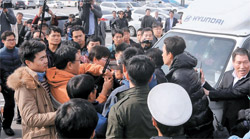Leaflets launched over DMZ blow back to South

지난달 29일 임진각에서 주민들이 대북 전단 보내기 국민연합 측 차량을 가로막고 있다. [연합뉴스]
Representatives of around 20 conservative civic groups launched seven balloons carrying 50,000 leaflets that criticize the regime’s third dynastic succession from a parking lot near the Imjin Pavilion in the border city of Paju, Gyeonggi, on Monday.
On Oct. 22, a group of North Korean defectors and civic activists were forcibly stopped by police from launching their leaflet-laden balloons after North Korea threatened artillery fire.
The South Korean government doesn’t want the launches in the midst of ultra-frosty inter-Korean relations and concrete threats from Pyongyang of retaliation at the border. But there’s no legal way to stop them.
However, some South Koreans are starting to question the effectiveness of the leaflet campaign.
Lee Min-bok, a North Korean defector and activist who has sent such leaflets to the regime for 13 years, said that balloons mostly tend to blow toward the northwestern regions of South Korea due to the winds and fail to get across the border.
“The Imjin Pavilion is the worst place to send balloons to the North,” Lee said. “Even in summer, winds near the Imjin Pavilion mostly blow from the southwest, so most balloons end up in cities [in South Korea] to the east, such as Pocheon, Yeoncheon and Cheolwon.”
“The best place for leaflet launch is Baengnyeong Island [in the Yellow Sea], because it faces North Korean territory.”
“It seems that most balloons sent from the Imjin Pavilion,” said an official at the state-run Korea Meteorological Administration, “will fly toward the East Sea at an altitude of 4,000 meters [13,125 feet] or 6,000 meters due to the westerlies.”
In 2011, a conservative group named North Korea Peace sent four large balloons carrying 800 pairs of socks and 800 leaflets on Christmas Day, but they blew across the border and then blew southwest to land on Ganghwa Island in Incheon.
Last January, an association of conservative organizations launched seven balloons. Two burst in the air, and five blew toward South Korean territory. In April, a large balloon launched near the Imjin Pavilion landed in Uijeongbu, northeast of Seoul.
Sources told the JoongAng Ilbo that a number of North Korean defectors dispatched leaflets last Dec. 21, two days after the announcement of the death of North Korean leader Kim Jong-il, but most failed to reach North Korean territory.
A police officer at the Pocheon Police Precinct near the Imjin Pavilion told the JoongAng Ilbo yesterday, “We often see balloons that are supposed to head to the North fall in the yard of the precinct.”
Some analysts say that some of the anti-North activists, who are mostly North Korean defectors, are less concerned about getting their message across the border than they are about promoting their organizations and attracting sponsors.
But Park Sang-hak, a North Korean defector who recently clashed with police at the Imjin Pavilion, said the campaigns are effective.
“The air currents on the Korean Peninsula change so frequently, five or six times a day,” Park said. “About 30 percent [of balloons] go across the border.
“It’s true that we intend to promote ourselves through those activities,” Park said. “However, if our leaflets indeed failed to reach the North, why is the regime so freaked out by our campaigns?”
By Han Young-ik, Kim Hee-jin [heejin@joongang.co.kr]










with the Korea JoongAng Daily
To write comments, please log in to one of the accounts.
Standards Board Policy (0/250자)